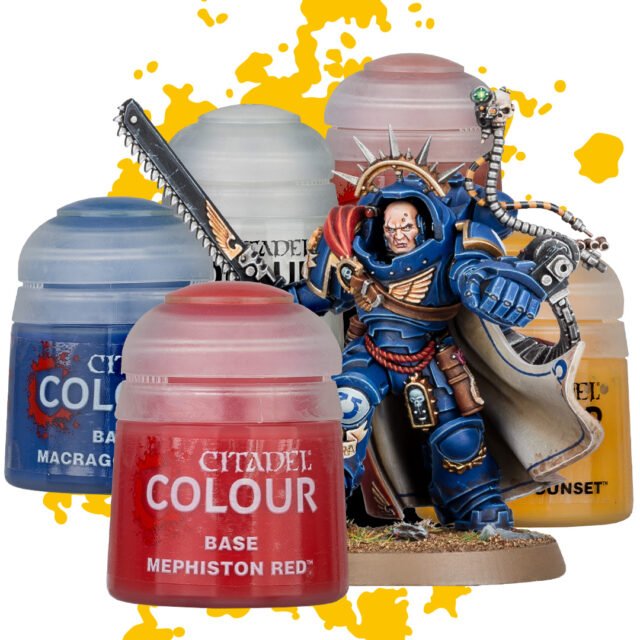So, you are ready to paint your miniatures for your dungeons & dragons or Warhammer games and wondering if you could use acrylic paint. One brand pops up in your mind -Citadel. But, are citadel paints really acrylic?
Citadel paints are acrylic and are formulated from multiple pigments . They have a thicker consistency than regular acrylics and unlike regular acrylic paints that can be used on various surfaces , citadel paints can be only used on surfaces such as resin, plastic and metal.
Even though citadel paints are acrylic, they differ a bit from Vallejo Paints and from regular acrylic paint. Before you get started on your project, here is everything you need to know about citadel paints.
You Might Also Like
- Are Vallejo Paints Acrylic?
- Is Rustoleum Spray Paint Acrylic?
- How to Hydro Dip with acrylic Paint?
- What are Acrylic Paints?
- Tempera Paint Vs Acrylic paint
What are Citadel Paints?

Just like Vallejo Paints, Citadel paints are a renowned line of high-quality acrylic paints specifically designed for miniature painting. Produced by Games Workshop, Citadel paints are widely recognized for their quality, vibrant pigments, and suitability for enhancing intricate details on miniatures. Citadel paints come in a wide variety of colors and types such as ; base paints, layer paints, shades, and more. These variations help ng artists bring their creations to life.
Citadel Paint Chemical Composition : What Are Citadel Paints Made Of?
The Truth is regular acrylics do not give great texture especially for a miniature. So, Citadel was introduced Games Workshop. Here is what Citadel paints are made of;
1) Pigments
Citadel paints are made of pigments because pigments are responsible for providing color to the paint. They are finely ground particles that possess specific hues and properties to create a wide range of colors. By incorporating pigments into Citadel paints, artists have access to a diverse palette to bring their miniatures to life with vibrant and rich colors.
Now, pigments used in Citadel paints are carefully selected for their lightfastness, stability, and quality to ensure long-lasting and high-quality paint finishes. These pigments allow for precise color control to achieve desired shades, highlights, and gradients on their miniatures.
2) Liquid Base
Citadel paints have a liquid base, specifically a water-based formulation. The liquid consistency of the paint ensures that it can be easily thinned or mixed offering artists greater control over color intensity and transparency. Furthermore, the liquid base facilitates the flow and levelling of the paint, enabling it to spread evenly and smoothly across the miniature’s surface. This characteristic is particularly important for achieving consistent and seamless paint layers, enhancing the overall appearance and detail of the miniature.
3) Water
Water serves as a solvent in citadel paint, which helps keep the pigments suspended and allows for easy application and blending. It helps the pigments remain suspended in the paint and promotes smooth application and blending. Water-based paints dry relatively quickly, enabling efficient layering and detailing. Overall, the use of water as the base in Citadel paints enhances their user-friendliness, safety, and overall quality.
4) Binders
Citadel paints have binders for several important reasons. For one, binders help the paint adhere to the surface of miniatures or other substrates. This sort of creates a strong bond between the paint and the material by minimizing the risk of flaking or peeling. Besides that, the binders also facilitate the formation of a continuous and durable film as the paint dries by protecting to the underlying surface, preserving the colors and enhancing the longevity of the painted miniatures.
5) Moisture
Citadel paints do contain a certain level of moisture that contributes to the drying process of Citadel paints. As water evaporates from the paint, it enables the paint to dry and form a durable film on the surface of the miniature. The moisture content affects the drying time, with water-based paints generally drying relatively quickly compared to other types of paints.
Recommended Product: Games Workshop Warhammer 40,000 Combat Patrol: Black Templars

Are Citadel Paints Acrylic?
Citadel paints are acrylic paints. They are formulated using water-based acrylic polymers as the binder, which provides adhesion and forms a durable film when the paint dries. Citadel paints are designed specifically for miniature painting and are known for their high-quality pigments, color vibrancy, and versatility. This makes them different from regular acrylic paints.
What Is the Difference Between Citadel Paint and Acrylic Paint?

When it comes to selecting the right paint for your artistic endeavours, two popular options often come to mind: Citadel paints and regular acrylic paints. While both offer their own unique qualities .Here’s how they differ;
1)Thickness
Citadel paints are known for their high viscosity and thick consistency. This characteristic makes them ideal for precise detailing and enhancing intricate features on miniatures. Regular acrylic paints, on the other hand, offer a broader range of thickness options. They come in various viscosities, including thick, thin, fluid, and runny variants, allowing artists to choose the consistency that suits their specific needs.
2)Pigmentation
Citadel paints are formulated using a combination of base, binder, and different types of pigments. This blend ensures vibrant and rich colors, particularly suitable for miniature painting. Regular acrylic paints typically consist of a base, binder, and a single pigment of a specific color. While they offer a wide range of colors, Citadel paints provide a broader selection specifically tailored for miniature enthusiasts.
3)Usage
Citadel paints are primarily designed for painting miniatures, especially those made of plastic, resin, or metal. They are formulated to adhere well to these surfaces and provide excellent coverage. Regular acrylic paints, on the other hand, are versatile and can be used on a variety of materials, including canvas, skin, paper, wood, metal, plastic, and shoes more. They are suitable for a wide range of artistic applications, from canvas paintings to mixed media projects. Interesting, you can also hydro dip with acrylic paint.
4)Pricing
Citadel paints are often priced at a higher range compared to regular acrylic paints. This is partly due to their specialized formulation and focus on miniature painting. Regular acrylic paints, being more widely available and catering to a broader market, tend to offer a wider price range, from budget-friendly options to higher-end professional-grade paints.
You might want to check out these budget-friendly top 10 best acrylic paints. I also have a review on the Best Neon Acrylic Paint, check it out as well if you want to create beautiful popping art.
5)Longevity
Citadel paints have an average shelf life of 5 to 7 years when stored properly. This ensures that the paints remain usable for an extended period. Regular acrylic paints, on the other hand, generally have a longer shelf life of around 10 years, provided they are stored in a cool and dry environment. The longer shelf life of regular acrylic paints allows artists to use them over a more extended period without concerns about deterioration.
Can You Use Citadel Paints in an Airbrush?
Citadel paints, renowned for their popularity among table top miniature enthusiasts, particularly in the Warhammer community, are not directly compatible with airbrushes due to their density. However, I recommend this Miniature Painting Kit . With the addition of a suitable thinning agent, the Citadel paint can be effectively diluted, making it compatible for airbrushing purposes.
How to Thin Citadel Paint for Airbrush?
Thinning Citadel paints for airbrushing requires careful preparation to achieve the right consistency for smooth and even application. Here’s a step-by-step guide on how to thin Citadel paint for airbrush use:
Materials
- Citadel Paint. Check out Game Injection Citadel Paint Build-Your-Own Assortment
- Paint Thinner( I recommend Vallejo Airbrush Thinner.) You can also use water and rubbing alcohol as a thinner
- Mixing Palette or container
- Stirring tool
Instructions
- Start with a small amount of Citadel paint: Squeeze a small amount of Citadel paint onto your mixing palette or container. It’s best to start with a conservative amount to avoid wasting paint.
- Add airbrush thinner gradually: Begin adding airbrush thinner to the Citadel paint. Start with a few drops at a time. The exact amount of thinner required may vary depending on the desired consistency and the specific Citadel paint color you are using.
- Stir and mix thoroughly: Use a stirring tool, such as a palette knife or a dedicated paint stirrer, to mix the Citadel paint and airbrush thinner together. Stir thoroughly until the paint and thinner are well blended. Ensure there are no clumps or lumps in the mixture.
- Check the consistency: Dip a clean brush or a stirrer into the thinned paint mixture and observe its flow. The paint should have a smooth and fluid consistency, similar to milk or cream. It should flow easily without being too runny or thick.
- Test spray and adjust if necessary: Transfer the thinned Citadel paint into your airbrush’s paint cup. Test spray the thinned paint on a spare surface or a test model. Observe the spray pattern, coverage, and consistency. If the paint is too thick or clogging the airbrush, add a few more drops of airbrush thinner and mix again. Repeat this process until you achieve the desired consistency and performance.
- Clean your airbrush: Once you have finished airbrushing with thinned Citadel paint, thoroughly clean your airbrush with an appropriate cleaning solution or water to prevent clogging and maintain its functionality.
Remember to experiment and adjust the thinning ratio based on the specific Citadel paint color and your preferences. You can also check out a separate article I have on how to thin out acrylic paint with water?
Can You Mix Citadel Paints With Acrylic Paint?
You can mix Citadel paints with other acrylic paints. Citadel paints are formulated using acrylic-based binders, making them compatible with other acrylic paints on the market. Mixing Citadel paints with acrylic paints from different brands or even different lines within the Citadel range can offer a wider range of colors and effects for your artwork. To mix Citadel paints with acrylic paints, follow these steps:
- Choose the Citadel paint and acrylic paint colors you want to mix. Consider the desired outcome and the color palette you wish to achieve.
- Use a clean palette or a mixing surface to combine the paints. It’s recommended to use a palette with separate wells or sections for each color, allowing you to control the ratios and avoid contaminating the original paint jars.
- Begin by squeezing a small amount of each paint color onto the palette. Start with a conservative amount ( 1:1 ratio) to avoid wasting paint and to allow for better control over the mixing process.
- Use a palette knife, a paintbrush, or a dedicated mixing tool to blend the Citadel paint and acrylic paint together.
- Mix the colors thoroughly until they are well incorporated and achieve the desired hue.
- Take a small sample of the mixed paint and apply it to a test surface or spare material. It is pretty much straight forward.
Do Citadel Paints Need Primer?
It is generally recommended to use a primer with Citadel paints before applying them to miniatures or other surfaces. Using a primer aids in achieving better paint application and control. The primer provides a slightly textured surface that helps the Citadel paint adhere evenly, minimizing issues like pooling or streaking. This allows for smoother brushwork and better control over the level of detail and precision in the painting process. The Games Workshop Warhammer 40,000 Citadel Corax White Spray Paint is perfect for your miniatures.
Recommended Product
Do You Mix Citadel Paints With Water?
Citadel paints can be mixed with water to adjust their consistency or for certain painting techniques. Water can be used to thin the paint, making it more transparent and suitable for techniques like glazing or layering. It can also help improve the flow and smoothness of the paint, allowing for easier brushwork.
When mixing Citadel paints with water, it is important to do so in small increments and gradually. Begin small, you can just add a small amount of water to the paint, mix it until you get your desired consistency. It’s essential to find the right balance, as adding too much water can result in a loss of color intensity and coverage.
It’s worth noting that some Citadel paints, particularly the layer paints, are already formulated with a slightly thinner consistency and may not require as much water for thinning. On the other hand, certain Citadel paints, like the texture or base paints, are designed to have a thicker consistency for specific applications.
How Long Do Citadel Paints Take to Dry?
Citadel paints typically dry to the touch within 15-30 minutes. However, it’s important to note that this is just a rough estimate, and the drying time can be influenced by the factors such as ;
- Paint Thickness
Thicker layers of paint will take longer to dry compared to thin layers. If you applied multiple layers or used techniques like layering or glazing, then you have to wait for a good idea to wait longer for each layer to dry completely before adding the next one to avoid smudging or mixing the wet paint.
- Temperatures
So, in humid or cold conditions, the drying time can be prolonged. I advice you to have proper ventilation and maintain a suitable temperature in your painting area. You should also know that darker or denser colors can take longer to dry compared to lighter or more transparent colors.
If you need to speed up the drying process, you can use techniques like using a hairdryer on a low heat setting, placing your painted miniature under a lamp, or using a dedicated drying aid product designed for miniature painting. Just be cautious not to use excessive heat or forceful airflow.
Best Citadel Paints
1) Citadel Base(Rhinox Hide)

2) Citadel Air: Troll Slayer Orange

3) Citadel Shade Drakenhof Nightshade

4) Citadel Pot de Peinture – Contrast Black Templar

Are Citadel Paints Flammable?
if you wondering whether Citadel paints are toxic and might catch fire, the truth is Citadel paints are considered non-flammable due to their water-based composition, making them a safe option for users. This quality is particularly advantageous when traveling, as there is no significant risk associated with transporting Citadel paints.
Recommended: The Army Painter Paint Set
Frequently Asked Questions
Can I Use Citadel on Large Projects?
Citadel paints are better used for miniatures and on small projects. if you want to use acrylic paint to your large projects, consider using students or professional acrylic paints
Are Citadel Paints Acrylic for Miniatures?
Citadel paints for miniatures are indeed acrylic-based. Citadel is a brand of paints manufactured by Games Workshop, specifically formulated for use in miniature painting for table top gaming.
Conclusion
In conclusion, Citadel paints are indeed acrylic paints. With their exceptional quality and wide range of vibrant colors, they provide a versatile and reliable option for anyone seeking to add a touch of excellence to their miniatures and artworks. Whether you’re a seasoned artist or just starting out, Citadel paints offer a world of creative possibilities.
SOURCES






